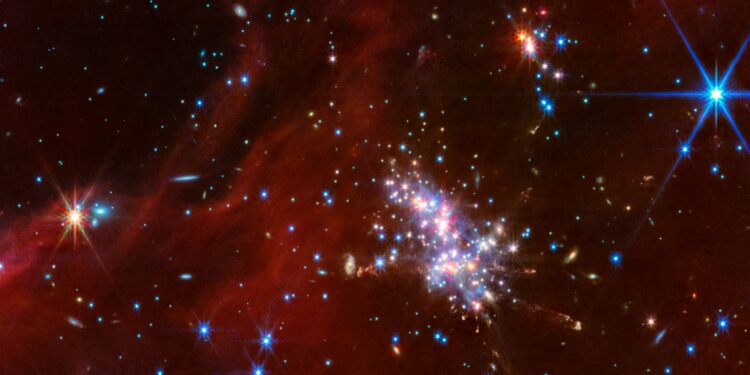NASA’s James Webb Space Telescope has been peering into the outer reaches of our Milky Way galaxy. Known as the extreme outer galaxy, this region is more than 58,000 light-years from the galactic center. To learn more about how a local environment affects the star formation process within this region, a team of scientists pointed the telescope’s Near-Infrared Camera (NIRCam) and Mid-Infrared Instrument (MIRI) at a total of four star-forming regions within the Digel clouds 1 and 2: 1A, 1B, 2N, and 2S. In the case of the 2S cloud, shown here, Webb revealed a bright main cluster that contains newly formed stars. Several of these young stars are emitting extended jets of material from their poles. To the upper right of the main cluster is a subcluster of stars, a feature that scientists previously suspected existed but has now been confirmed by Webb. In addition, the telescope revealed a deep sea of background galaxies and red nebulous structures that are carved out by winds and radiation from nearby stars. Credit: NASA, ESA, CSA, STScI, Michael Ressler (NASA-JPL)
Astronomers have been using NASA’s James Webb Space Telescope to peer into the outer reaches of our Milky Way galaxy. Scientists call this region the extreme outer galaxy because it is more than 58,000 light-years from the galactic center. (For comparison, Earth is about 26,000 light-years from the center.)
A team of scientists used Webb’s Near-Infrared Camera (NIRCam) and Mid-Infrared Instrument (MIRI) to image selected regions within two molecular clouds known as Digel Clouds 1 and 2. With their high sensitivity and sharp resolution, Webb’s data captured these areas, which are home to star clusters undergoing bursts of star formation, in unprecedented detail. Details in the data include cluster components such as very young (class 0) protostars, outflows and jets, and characteristic nebular structures.
These results were published in the Astronomy Journal.
These Webb observations, which come from telescope time allocated to Mike Ressler of NASA’s Jet Propulsion Laboratory in California, allow scientists to study star formation in the outer Milky Way with the same depth of detail as observations of star formation in our own solar neighborhood.
“In the past, we knew about these star-forming regions, but we were unable to study their properties in depth,” said Natsuko Izumi of Gifu University and the National Astronomical Observatory of Japan, lead author of the study.
“The Webb data builds on what we have been gradually collecting over the years from previous observations with different telescopes and observatories. We can get very powerful and impressive images of these clouds with Webb. In the case of Digel Cloud 2, I did not expect to see such active star formation and such spectacular jets.”
Stars in the making
Although the Digel clouds are located in our galaxy, they are relatively poor in elements heavier than hydrogen and helium. This composition makes them similar to dwarf galaxies and our own early Milky Way. Therefore, the team took the opportunity to use Webb to capture activity occurring in four clusters of young stars within the Digel clouds 1 and 2: 1A, 1B, 2N, and 2S.
For Cloud 2S, Webb captured the main cluster containing young, newly formed stars. This dense area is very active because several stars are emitting extended jets of material along their poles. Additionally, while scientists previously suspected the presence of a subcluster within the cloud, Webb’s imaging capabilities confirmed its existence for the first time.
“We know from studying other nearby star-forming regions that when stars form in their early stages of life, they begin to emit jets of material from their poles,” said Ressler, second author of the study and principal investigator of the observing program.
“What fascinated me and amazed me about the Webb data is that there are multiple jets coming out of this star cluster in all directions. It’s kind of like a firecracker, where you see things going in one direction or the other.”
The Star Saga
Webb’s images scratch the surface of the extreme outer galaxy and the Digel clouds, and are just a starting point for the team. They plan to revisit this Milky Way outpost to find answers to a variety of current mysteries, including the relative abundance of stars of different masses within star clusters in the extreme outer galaxy. This measurement can help astronomers understand how a particular environment can influence different types of stars as they form.
“I want to continue studying how star formation occurs in these regions. By combining data from different observatories and telescopes, we can examine each step of the evolution process,” Izumi said.
“We also plan to study circumstellar disks in the extreme outer galaxy. We still don’t know why their lifetime is shorter than in star-forming regions much closer to us. And of course, I would like to understand the kinematics of the jets we detected in the 2S cloud.”
Although the story of star formation is complex and some chapters remain shrouded in mystery, Webb pieces together clues and helps astronomers unravel this complex story.
More information:
Natsuko Izumi et al., Overview of results from JWST observations of star-forming clusters in the extreme outer galaxy, The Astronomical Journal (2024). DOI: 10.3847/1538-3881/ad4e2e
Quote: Webb peers into the extreme outer galaxy (2024, September 12) retrieved September 12, 2024 from
This document is subject to copyright. Apart from any fair dealing for the purpose of private study or research, no part may be reproduced without written permission. The content is provided for informational purposes only.



